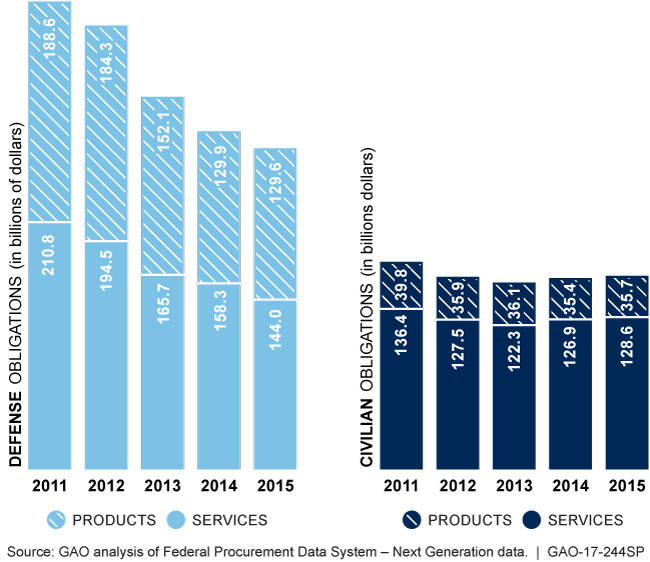Defense spending decreased by almost 31 percent between 2011 and 2015, while civilian obligations remained steady, according to an analysis of governmentwide contracting by the Government Accountability Office.
Looking at trends of the government’s discretionary spending over a five-year period (which included 2013’s sequestration), the GAO found procurement activity at military departments during fiscal 2015 — primarily the Air Force, Army and Navy — dropped from nearly $211 billion in services and $186 billion in goods to $144 billion in services and $129 billion in goods.
Meanwhile, the civilian agencies with the highest obligations on contracts during that same time period — led by the departments of Health and Human Services, Homeland Security, Justice, State, Commerce, and Transportation, as well as the U.S. Agency for International development, General Services Administration and NASA — spent around $136 billion on services and $40 billion in products for 2011 and $127 billion on services and $36 billion in products in 2015.
Professional support services accounted for the top services procurements at both defense and civilian agencies, followed by maintenance, repair and rebuilding of equipment for defense agencies, as well as IT and telecommunications for civilian agencies. The construction and operation of structures and facilities also factored into each sector
Top products were aerospace craft and structural components for defense agencies, as well as medical, dental, and veterinary equipment and supplies for civilian agencies. 
Of those obligations, competitive contracts remained relatively steady, rising from 75.8 to 79.4 percent for civilian agencies and decreasing from 58.4 to 55.4 percent for defense organizations. Fixed-price contracts made up an average of 63 percent of obligations.
GAO feels that the initiatives Congress and the administration have taken to simplify and strengthen procurement practices and enhance oversight of contract spending have reduced government waste and risk for the $430 billion obligated in fiscal 2015. Lessons learned from reviews can help duplication and increase savings, with professional and management support services needing particular attention.
All analysis was derived from the Federal Procurement Data System — Next Generation, the government’s procurement database, and prior GAO and inspector general reports.
The complete report, with many breakdowns of specific agency obligations, can be accessed on GAO’s website.





